More than 270 thousand people do the Preikestolen hike every year, eager to reach one of the most famous cliffs in Norway, also known as Priest Rock or Pulpit Rock. The experience is terrific and terrifying at the same time.
If you finish the Preikestolen hike without vertigo, congratulations!
Preikestolen reached the stardom even before Travis Fimmel sat on it in “Vikings”, and even more before Tom Cruise hanged from it in “Mission Impossible: Fallout”. On a side note, the latter one pretends that the Pulpit Rock cliff is actually not in Norway, but in Kashmir, India! That did not slow down the constant rise of touristic interest in this unique Norwegian lookout.
Follow this guide, and learn how to experience Preikestolen hike in the most enjoyable way, but also safely, without accidents or, worse, becoming a part of Preikestolen deaths statistics.
If you manage to finish the Priest Rock trail without vertigo, Norway will congratulate you! You’ll become a part of the fearless hiking family that is consistently defending Preikestolen’s reputation as one of the best hikes in Norway.
Preikestolen history
The famous hanging rock of Preikestolen was formed in the ice age, 10.000 years ago, during the melting of the Lysefjord glacier.
The water that froze in the mountain crevices broke off large blocks that the glacier carried away. Pulpit Rock resisted and stayed on the top as if somebody would have carved it out with a knife.
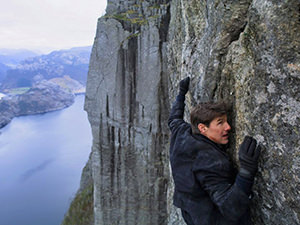
The mountain plateau gained its touristic boost at the beginning of the 20th century.
Preikestolen star history starts with the gymnast Thomas Peter Randulff who conquered it first, after seeing it from the steamboat.
The captain of the boat was the one who pointed at the big rock above the fjord, saying that it resembled a preacher’s pulpit (preikestolen). This is how the rock formation previously known as Hyvlatonnå (planed tooth) got its modern name.
If you want to visit more daring rocks in the area, definitely check Kjeragbolten!
Priest Rock lookout as a test of bravery and intelligence
This flat mountain plateau protrudes roughly 30 meters from the mountainside, which efficiently produces gooseflesh in an average visitor.
Yet the call of the selfie at the edge of the cliff is irresistible for the most.
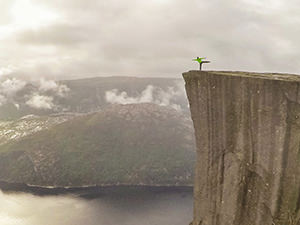
One doesn’t need to be a priest to peep out from the Pulpit Rock lookout. Many visitors lie down on their bellies while peeking over the edge into the abyss. The braver ones sit on it with their legs freely hanging, while some parents with a dubious sense of responsibility let their baby crawl on the mountain ledge so they can snap that perfect photo.
The visitors open to extreme sports in the challenging setting engage in doing one-armed handstands, BASE jumping, slackline walking, trampoline jumping, or even something as stupid as free-hanging from the cliff.
If you want to hike in an even more dangerous setting, head to Indonesia. Kawah Ijen Volcano is the most toxic place one can climb!
Preikestolen hike trail – ups and downs
Even if the square-shaped rock high above the fjord is the primary goal for most of the hikers, the scenery along the path to Preikestolen is equally breathtaking. Lush pine forests, boardwalks and bridges, lakes, and cascades. It all adds to the beauty of the hiking experience.
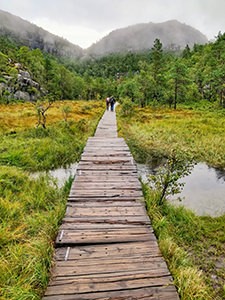
Preikestolen hiking trail is well signposted by the Trekking Association’s red-painted T-markers. There are also signs showing the distance to the top and back to the Preikestolen parking, where the hike starts. With so many people going, one could hardly get lost anyway; just follow the crowds!
Parts of the path are granite stairs that were laid down by Sherpas from Nepal. This made hiking to Preikestolen easier than it was before.
It is still a physically demanding adventure for most people.
Preikestolen hike with baby falls under this category. Even if I have seen hikers with small dogs and parents with small children, I would advise you to bring the weaker ones on the Preikestolen hike only if you are prepared for a lot of stops and extra weight on your shoulders when kids decide to give up walking.
Florli in the neighborhood is another great base for stunning hikes, including the longest stairs in the world.
Preikestolen deaths
With the long history of touristic exploitation, it is unusual that there have not been many Preikestolen deaths and accidents.
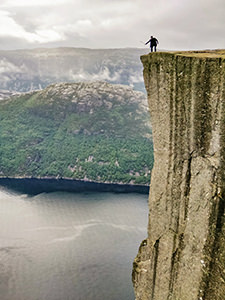
In 2013, Diego Garcia Calleja (26) seemed to be the first tourist to die from the accidental fall from the Pulpit Rock. His travel companions reported that before heading down from the mountain, the Spanish hiker returned to take a few more photographs, and then they heard the scream. Only after his death, an automated farewell message appeared on his Facebook wall, revealing that he wanted to end his life in a “nice place”.
An Austrian woman and a Norwegian man made the same choice earlier; in 2000, they formed the suicide pact on the internet and jumped together off the Pulpit Rock to their deaths.
Whether with an intention or by accident, modern tourists approach the Pulpit Rock edge quite carelessly. The authorities were considering fencing the rock, but the idea quickly fell through the cracks.
The fence would definitely affect the aesthetics of the site. There was also an understandable fear that the fence would motivate even riskier behavior of the adventurous tourists.
Maybe it is more beneficial to teach that Norwegian nature is dangerous, and we should approach it with respect.
Don’t play James Bond, and you should be fine, just like the other 270.000 careful visitors every year! Well, except those that make Norwegian People’s Aid arrive in helicopters to perform several dozens of rescue operations per year due to hiking injuries at Preikestolen.
Will Preikestolen fall?
Yes, it definitely will. The future when this will happen is however not foreseeable.
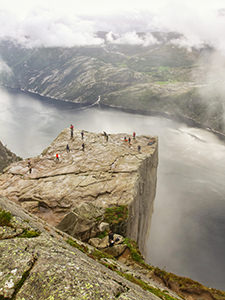
Pulpit Rock crack is several meters deep, and in 2017 the measurements concluded that the gap has widened by 2-3 millimeters. As The Local reported, geologists will continue monitoring the site.
The legend says that Preikestolen will tear itself off the mountain when seven sisters marry seven brothers from the Lysefjord area. The fall of the plateau into the fjord will create a tsunami that will kill everyone in the area.
A similar scenario already happened in Norway in 1934, when the wave resulting from the mountain rockfall in Tafjord killed more than 40 people.
As “The Wave”, Norway’s disaster movie from 2015 shows, we should never underestimate the unpredictability of nature.
For additional excitement, would you try climbing mountains with no clothes on? Meet Erik, the naked hiker!
Preikestolen hike – when to go?
Preikestolen hiking season is open from April till October.
Beware, June, July and August are the busiest periods, so aim for the shoulder season to enjoy the place with lesser crowds.
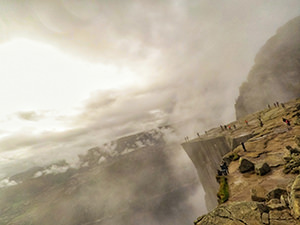
The best time to visit Preikestolen would probably be May and September, as a good compromise between the weather conditions and site popularity.
Preikestolen winter hike is possible, but only with an organized guided tour. Early spring and late autumn hikes might make the paths more slippery due to the rains.
Shoot for the weekday if you can, this will also reduce stumbling on people on the Priest Rock trail.
Another fjord you should add to your itinerary is Aurlandsfjord, not far from Bergen.
Preikestolen – where to stay?
The nearest airport to Preikestolen is the one in Stavanger. I decided to stay in this town as it has a charm of its own, but is also quite well connected with Pulpit Rock.
I booked a room through Airbnb, just 300 meters away from the Fiskepiren ferry terminal. This convenient option cost me 37 Euros per night.
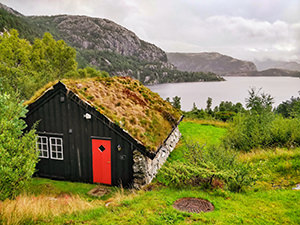
If you want to stay closer to Priest Rock, the obvious choice is Preikestolen Mountain Lodge (Preikestolen Fjellstue). The daily price is between 380 and 1275 Norwegian Krowns (40-132 Euros), depending on whether you stay in a dormitory or a single room with a private bathroom. Check out the photographs and prices here!
Then there is the closest place to Preikestolen, and that is the self-organized camping near the rock itself. Thanks to the liberal Norwegian laws about camping in nature, this option is – free! It will also enable a less stressful hiking experience, as well as the possibility of enjoying the Pulpit Rock site during sunset or sunrise without the tourist jam.
Still wondering where to stay close to Preikestolen?
Check out these hot deals!
Various dates available!
How to get to Preikestolen?
Getting from Stavanger to Preikestolen is very easy. One needs to take the ferry from Stavanger to Tau, and then the bus from Tau to Pulpit Rock parking, the starting point of the hike. The hiking route from Preikestolen Mountain Lodge is clearly marked.
Tide offers the combined ferry and bus ticket for 340 NOK (36 euros). Pulpit Rock Tours offers a bus ride for 210 NOK (22 euros), while the ferry ticket should be bought on board (120 NOK or 13 euros round tour).
If you are coming by car, the parking fee at Preikestolen parking costs 200 NOK (21 euro).
For a complete peace of mind, join a safe guided hike with a pick-up in Stavanger for 1,190 NOK (104 euros).
Preikestolen hike facts
- Preikestolen height: 604 meters
- Hike elevation: 334 meters
- Trail length (one way): 3,8 kilometers
- Preikestolen hike time (one way): 2 hours
- Difficulty: medium
- Preikestolen weather: Check yr.no, the highly reliable Norwegian weather forecasting site
- Fun fact: In 2016, Eirik Ulltang did Preikestolen hike on a bicycle – it took him 2 hours only as if he would’ve been an average walking hiker!
Did you like this article on Preikestolen hike?
Pin it for later!
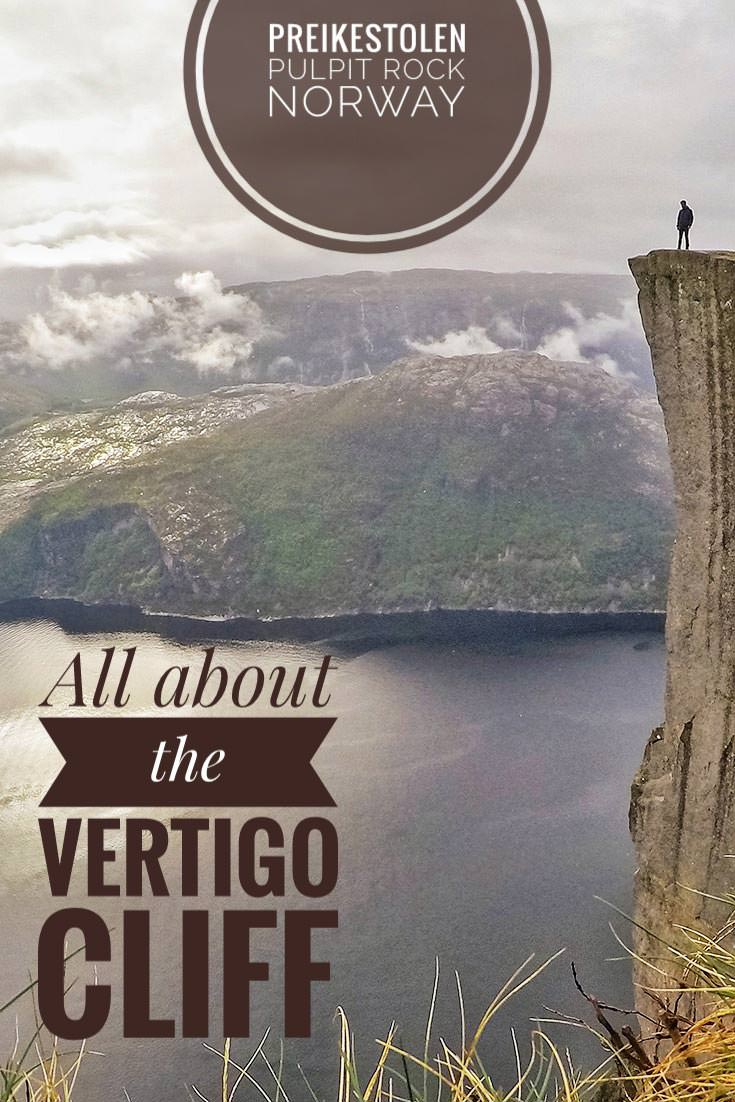
Disclosure: This post contains affiliate links, which means if you click on them and make a purchase, Pipeaway might make a small commission, at no additional cost to you. Thank you for supporting our work!

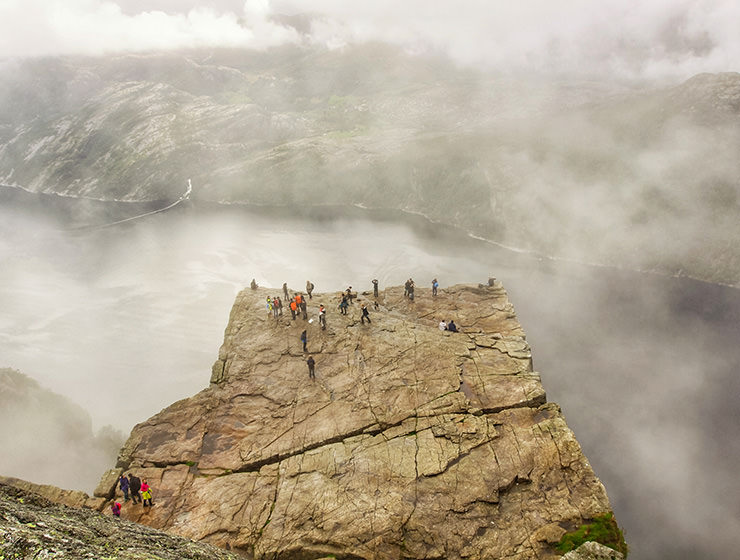

Awesome article! Your attention to detail is amazing and I love the history behind Preikestolen as well! I will certainly be using this when I travel to Norway. Looking forward to reading more!
Thanks, Keri! Stay tuned – more amazing Norwegian adventures coming to the site soon!